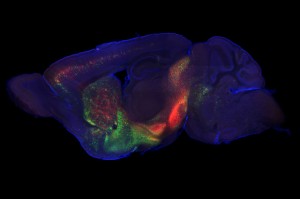Researchers at the U.S. Department of Energy’s Brookhaven National Laboratory have developed a new mapping protocol that allows them to visualize the activity of dopamine, the brain’s reward circuitry, in both healthy individuals and those addicted to drugs and alcohol. This new dopamine mapping technique may offer better insight into why people partake in the use of drugs and alcohol as well as determine which treatment protocols may be the most effective.
 Using positron emission tomography (PET), which is medical imaging technology used in identifying brain diseases, and radioactive tracers that bind to dopamine receptors. The PET scan highlights the movement of the tracers in the brain. This is then used to reconstruct real-time 3D images of the dopamine system at work. (Medical News Today)
Using positron emission tomography (PET), which is medical imaging technology used in identifying brain diseases, and radioactive tracers that bind to dopamine receptors. The PET scan highlights the movement of the tracers in the brain. This is then used to reconstruct real-time 3D images of the dopamine system at work. (Medical News Today)
Although it’s understood by the scientific community that drug addiction is a complex process consisting of many biological and environmental factors, it’s clear that the role of dopamine is central to the understanding substance abuse. Dopamine is the chemical that regulates reward and pleasure in the brain. The study found that the addicted individuals had 15-20 percent fewer dopamine receptors than those in the control group (healthy individuals). (Medical News Today)
One of the scientists at Brookhaven explained that individuals suffering from the disease of addiction all have “blunted dopamine response.” This understanding reinforces previous notions that addicts “experience diminished feelings of pleasure, which drives their continual drug [and alcohol] use” and furthers the damage to the reward center of the brain. The study looked at the results of various types of drugs. And although each operated by unique mechanisms, they all shared one thing in common: the dopamine receptors in addicted brains demonstrated an under-stimulated reward system.
Therapies such as Neurotransmitter Restoration (NTR) support the findings of this study in understanding the key role of dopamine in addiction and addiction recovery. NTR is a medical nutritional therapy that bathes the neuronal cells in an optimal, nutritional environment, stimulating dopamine receptors to induce repair and accelerate the brain’s healing process.
Researchers hope that the real-time aspect of the new imaging protocol may prove to be valuable because it doesn’t require looking at individuals while they are under the influence of drugs or alcohol, but rather when they aren’t. This will allow for examining how different coping strategies of rehabilitation and abstinence work best.


